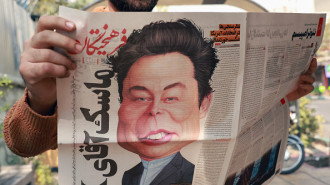RSF 'closing in' on Sudanese army HQ in North Darfur's El Fasher
The paramilitary Rapid Support Forces (RSF) are close to seizing full control of Sudan’s El Fasher city from the rival Sudanese Armed Forces (SAF) after months of intensive battles in the North Darfur State.
The area is home to Zamzam camp, one of the country’s largest internally displaced camps where thousands have fled since the outbreak of fighting between the two rival military groups in April 2023.
The RSF first moved on El Fasher, a Sudanese army stronghold, in April, but has recently pushed into the centre, closing in on the SAF’s military headquarters, according to researchers.
Yale Humanitarian Research Lab, which has been tracking the conflict using satellite imagery, found that “defensive positions” have been set up in Zamzam camp, suggesting those on the ground are expecting an imminent attack.
There have been growing concerns over the possibility of mass atrocities and ethnic cleansings at the hands of both the RSF and SAF.
The RSF, which is reportedly receiving support by the United Arab Emirates as well as other local Arab militias, conducted massacres against the Zaghawa ethnic group in north Darfur in October, according to campaign group Avaaz.
The latest round of violence began in the African country in April 2023 and snowballed into a civil war when long-simmering tensions between the military, led by Gen. Abdel Fattah al-Burhan, and the RSF paramilitary commanded by Mohammed Hamdan Dagalo (also known as 'Hemedti'), broke out into street battles in the capital, Khartoum.
The RSF has been blamed for mass killings of civilians, which are often ethnically driven, as well as numerous human rights violations including terrifying levels of sexual violence.
The war has uprooted swathes of the population and humanitarian workers have described the conditions as among the worst in the world.
Aid supplies reached Zamzam camp this week for the first time in months as thousands of people have been facing famine-like conditions as a result of the expanding conflict.
The UN World Food Programme (WFP) said three convoys had delivered food and nutrition assistance to the camp in the stricken North Darfur region.
Eddie Rowe, WFP’s Sudan Country Director, said the convoys were “a lifeline for the people of Zamzam,” in comments carried by the Sudan Tribune on Friday.
The deliveries come after Sudanese authorities allowed the Adre border crossing point from Chad to Darfur to remain open for a further three months on 13 November.
It was reopened in mid-August following pleas from the international community to improve the dire humanitarian situation for some 25 million Sudanese who are in need of support.
The crossing point is particularly crucial for those in Darfur province that borders Chad and has been embroiled in instability since earlier this year.
The United Nations Resident and Humanitarian Coordinator in Sudan, Clementine Nkweta-Salami, said on Thursday that the border crossing was a “critical lifeline for hundreds of thousands of vulnerable people across the country, especially in Darfur.”
The UN’s OCHA agency has warned that acute malnutrition rates “remain above the famine threshold” in Zamzam camp in North Darfur.
International NGO Medecins Sans Frontieres estimates that as many as 500,000 people are living in the camp, which was established long before the outbreak of the current conflict.
A new report published by experts in Sudan and Britain earlier this week found that the conflict’s death toll was significantly higher than previous estimates. The study by the London School of Hygiene and Tropical Medicine’s Sudan Research Group estimates that more than 61,000 people have died in Khartoum state alone during the first 14 months of the conflict.
The estimate includes violent deaths and a large proportion from starvation and disease.







 Follow the Middle East's top stories in English at The New Arab on Google News
Follow the Middle East's top stories in English at The New Arab on Google News
![Lebanon after strikes [Getty]](/sites/default/files/styles/image_330x185/public/2184409977.jpeg?h=a5f2f23a&itok=7wpfQMyI)
![G20 Brazil [Getty]](/sites/default/files/styles/image_330x185/public/2184389194.jpeg?h=a5f2f23a&itok=t1DchCMY)
